Strange Attraction
How to generate leads for an independent consulting practice
The Lorenz Attractor is a chaotic system - a strange attractor. It’s an elegant and beautiful mathematical object that looks a bit like this:

Chaotic systems are often referenced in popular culture via the well-known butterfly effect: “Does the flap of a butterfly’s wings in Brazil set off a tornado in Texas?”.
The general principle with chaotic systems is that no matter how carefully you try and control the inputs, the outputs will always surprise you.
This… sounds a lot like the lead flow for my consulting business!
After doing this for 4 years it’s still a surprise when and where leads come through - almost every time it’s “why did this happen? Why now?”.
But it doesn’t mean the whole thing is random! There’s a distinction between random systems and chaotic systems. If you look at the Lorenz Attractor you can tell it’s not random - there’s a system at work - the key with chaotic systems is that you can’t control for individual outputs, but you can shape the system at large.
In this post I’m going to break down my personal system and philosophy for generating leads for my consulting practice - embracing the chaos of generating warm leads from real humans. It all boils down to controlling for system-level outputs not individual outcomes by focusing on the following:
- Focus on networks over networking
- Articulate your work
- Publish to be present
I’ll explain, but first:
A quick primer on my work
It’s worth explaining the kind of work I do, with some important caveats. I do strategic consulting work as an independent. Often I’m embedded within a client’s organization and often for long periods of time1 (for example - think two days a week in the office for 18 months working across a variety of projects).
This means that - for me - I’m primarily concerned with warm leads for long term strategic work.
It’s important for leads to be warm - because it’s hard to convince someone to spend $20k / month on a consulting contract without them already thinking they might spend money on consulting (and having some kind of budget earmarked!)
It’s important for leads to be primed for long term strategic work - because you want large enough problems that the senior leadership of the business is talking to you (this helps you get paid well and helps you have a bigger impact) and you want retained work that lasts2 (this helps you smooth revenue gaps and gain some predictability).
This means that for me - I’m definitely optimizing for quality over quantity. 5-10 leads a year can keep me full up. And I think for many independents this will be and should be the case - optimizing for quantity will create a very different environment.
The varieties of styles and approaches to independent work will surprise you so I won’t claim to say this is the only way to do things but it works for me so maybe you’ll learn something to add to your own approach.
All my friends are strange attractors
The Lorenz System is classified as a strange attractor - as mentioned above it’s a chaotic system - which means that no matter how closely you observe the initial conditions you will always be surprised by the output.

Aside from being beautiful (and the loops looking the wings of a butterfly if you squint!) I find this visualization oddly satisfying and descriptive of two people’s lives. Their orbits entwined - strangely.
I imagine every relationship as some kind of Lorenz strange loop - with us at times orbiting closely and at times drifting apart. This notion of friendship with vast unknowable orbits.
But people - humans - contacts - friends - is where I get all of my business from. All of the leads for my consulting business come from a small number of people. In fact, running the numbers 60% of my all-time consulting revenue can be traced to just four people:
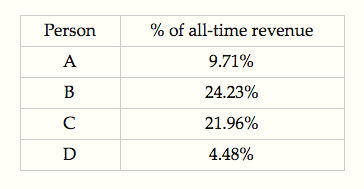
What does this feel like in practice?
A butterfly flutters
Somewhere in London in 2010(?) I met two gentlemen at a networking dinner. If I’m honest I don’t recall this in any way shape or form. But someone I worked with in London around the same time who is now a close friend popped into my inbox in 2016 to make a strange attraction intro…
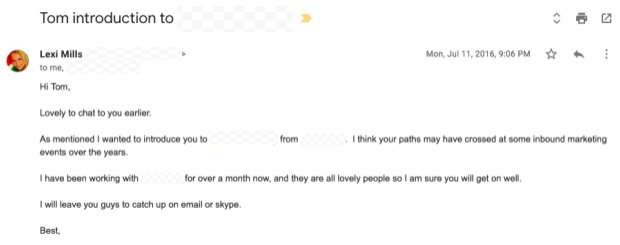
This lead turned into one of the biggest single sources of consulting revenue since I’ve been out on my own.
Another one:
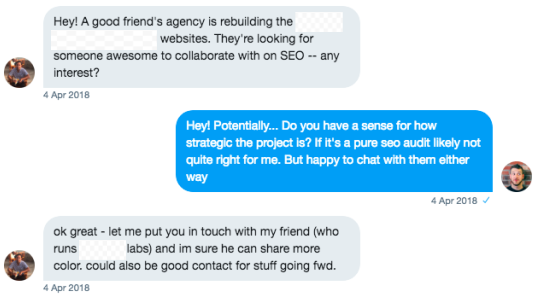
This turned into a super-useful project for me that snowballed into the last year working in media. Funny how those things go.
Sometimes though it’s people you don’t know very well. This is someone who I interviewed for a senior role at a previous job - who then turned the tables and put me forward for a consulting gig:
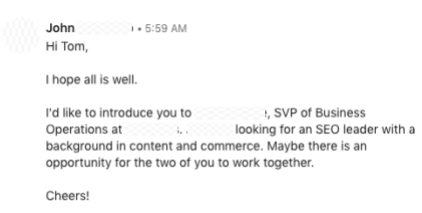
Ok - so… Humans power this whole warm-leads business.
But of all the humans I know - why these ones? Is it random? How can we motivate people to send us work? There’s two things you can do - build a network and talk to them.
Ways to build a network of strange attractors
It’s obvious - but often overlooked - that to build a flow of warm referrals you need to have a network of folks who know you, and know what projects you’re a good fit for. So how do you build a larger network? Some approaches:
Public Groups
My friend Carly Ayres (who just sunsetted her studio - RIP Hawraf) hosts a meetup series called 100s under 100. It’s a friends of friends kind of thing but open to a large group (these meetups range from a small group to 100s).
My friend Mark Pollard runs Sweathead a public FB group for strategists. He’s a community-building natural and he actively cultivates community, engagement and audience - for example he has a Sweathead podcast that interviews many people from the community itself.
These events are a great platform to build awareness and large groups of loose networks as well as gain authority by being the public figure-head of a large group.
Private Groups
I know a variety of private invite-only groups - most of these happen on Slack these days. One in particular that is especially high signal-to-noise is the Sunday Dinners slack group. This group is small, has less virtue signaling - since it’s private - but can be a wonderful way to build a more intimate group of close ties. These private groups are typically <150 members. Anything above that and I think you start to lose the intimate nature and it turns into something more akin to a public group.
One advantage of these private groups is the ability to discuss work-in-progress and the more raw side of client / project challenges and success. This can help bridge a true picture of what work looks like for you which sets you up for success when cultivating warm intros.
Small Gatherings
Over the past two years I’ve been hosting invite-only dinner events. They usually run 10-15 people and, honestly, are a weird mix of my actual friends, people I know doing interesting things and people who I know will get value from the weird mix I put together. There’s no structure to these events but they form bonds and connections between many different people in my networks.
Across all three of these approaches - the key is to be the anchor of the network. By being the anchor you gain an order of magnitude more recognition and exposure than merely attending someone else’s event or being a member in someone else’s slack. Being the anchor of a group of 10 is better than being a member of a group of 100 (though of course they’re not mutually exclusive!).
Strange communication - aka talking to your network
It’s not enough to just have a network though. You need to talk to them for two key reasons:
Firstly - the key to getting good leads is helping your network understand what opportunities you might be a good fit for. You have to help your network understand what you do and how you think. This is so much more than just “marketing work” - you need to really get granular. If you look back at the human warm leads above they all had a specific point of entry - for example “SEO leader with a background in content and commerce”. You need to talk and share with your network so that they can find these specific reference points for a warm intro.
Secondly - being top of mind is, remarkably, an effective tactic. Humans are wired for recency so if someone saw a post or email of yours recently they’ll be much more likely to put you forward for work. Especially the further out you go in the fringes of your network you need to be seen to be remembered.
If you look at the above examples - 100 under 100, Sweathead, Sunday Dinners, my own dinner series - every single one is a great platform that is taken advantage of by the owners to educate and talk about the work they do beyond just sharing client names. This creates a great surface area to cultivate the right kinds of work from your network.
So, listen, I’m gonna sound like a broken record, but the blog+newsletter combo is a great answer. For independents you have to carve out your own little space to write and distribute your ideas. And don’t worry about chasing scale. From my piece small b blogging:
small b blogging. It’s a virtuous cycle of making interesting connections while also being a way to clarify and strengthen my own ideas. I’m not reaching a big audience by any measure but the direct impact and benefit is material.
Small b blogging is learning to write and think with the network. Small b blogging is writing content designed for small deliberate audiences and showing it to them. Small b blogging is deliberately chasing interesting ideas over pageviews and scale. An attempt at genuine connection vs the gloss and polish and mass market of most “content marketing”.
On butterflies and sea-gulls
Remember that chaos-theory-butterfly anecdote?
“Does the flap of a butterfly’s wings in Brazil set off a tornado in Texas?”
Well, it was originally a quote about sea-gulls:
“One meteorologist remarked that if the theory were correct, one flap of a sea gull’s wings would be enough to alter the course of the weather forever. The controversy has not yet been settled, but the most recent evidence seems to favor the sea gulls.”

The poor ugly un-poetic seagull3.
What’s the story here? The lesson is that language is a virus. Design your case studies to be pithy - talk about your work in small fragments that can be repeated in oral culture:
- “Commerce and content”
- “Hired a team of 10”
- “Interim CMO”
These short phrases can sum up and signal so much to the right person at the right time - and you can use many of them at once. This is an ongoing project of listening to how people make intros for you - and noting the little phrases they use. How are people understanding and describing your work in the two-line email?
Reducing ambiguity using a capabilities deck
There’s a problem with warm leads though - you get caught up in email FW: FW: intros and nebulous-sounding intros and requests. This is a two-sided problem - it’s hard for you to know which ones are worth your time, and it’s hard for the other party to know if you’re a good fit for their needs.
I’ve found that having a “capabilities deck” - i.e. a PDF that summarizes the work you do and who do it for - is useful and helpful in closing the right kinds of work.
For example - see this email exchange:
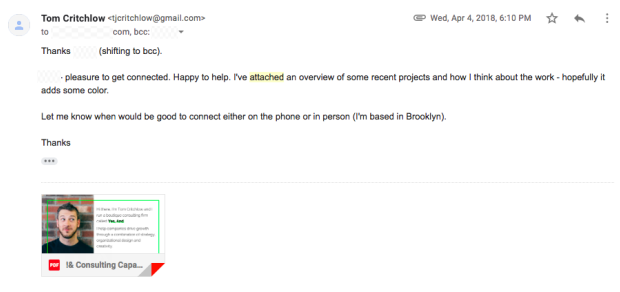
In this example - a warm intro has become a luke-warm intro. I’ve never met or talked to person A who’s intro-ing me to person B. This is often the kind of thing that goes no-where. So I throw out a “pleasure to meet you, here’s a PDF, let me know if there’s a fit?”.
That email turned into a big project, and it was the second time I’d ever used a PDF attachment to explain my work.
The very first time I used a capabilities deck attachment? This one:
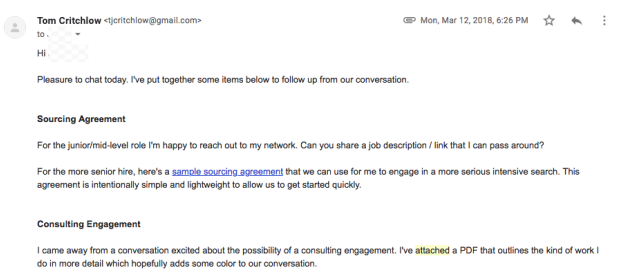
This email - in March - closed 6 months later. I attached my capabilities deck as a “hey, also” but it worked.
When you first start out as a consultant - I’m not entirely sure a capabilities deck is the right thing to spend time and energy on. You’ll likely not have enough stuff to put in it and you’ll spin your wheels with the language you use. But once you have completed a few projects and are starting to generate enough of these warm leads I think it can be a useful tool to have.
Looking for an example? Check out Mark Pollard’s for a good public example.
There’s much more to be written about how to put one of these together4 but for now I think aim to be concise and precise. Aim for 10 slides. Be specific about what you do.
The weird many-colored butterfly
I want to take a moment to talk about “weird work”. Many independents feel trapped in a box - unable to “break out” into work that they either want to do or feel interested in. I asked Venkatesh Rao how to find more alternative work out of your comfort zone and he said this (bolding mine):
I think you just have to do whatever most energizes you and produces a lot of output, and let the work/opportunities find you. I have never gotten an enjoyable weird gig out of going fishing myself. You choose boring, normal work, but interesting, weird work chooses you.
Quantity has a quality all its own as Lenin said. The sheer volume of your work is what works as a signal of weirdness, because anyone can be do a one-off weird thing, but only volume can signal a consistently weird production sensibility that will inspire people betting on you. The energy evident in a body of work is the most honest signal about it that makes people trust you to do things for them.
This quote is very true for weird work - but applies to any kind of new direction you want to take. Only volume can signal a specific sensibility that makes people trust you to do things for them.
So if you want more work in a specific vein - write about it! Talk about it! Consistent output will get you there - though of course the flip side of this is that you have to recognize that it can take time to build up this output so likely won’t happen quickly.
Podcasts & conferences - oral traditions of storytelling
Because we’re focusing on generating warm leads from real humans - it’s not just about what you say but also how you say it. The oral tradition is important. Conferences and podcasts are two accessible platforms for telling human - oral - stories.
As an independent it can be hard to break into the conference and podcast circuit. Typically you are lacking the recognized labels and power that comes with a full time job to be considered by organizers and hosts.
There’s a whole blog post brewing in me about the specific challenges of getting invited to speak as an independent - the crux of it I think boils down to making “things with labels”. Books, art projects, websites, communities, etc are all great ways to build some semblance of “trust totems” that an organizer or host can recognize and use to invite you into the spotlight.
Nothing allows you to forge human connections at scale quite like the spoken word. So you should leap at these opportunities - tell you story and talk about the work (at least a little).
On catching butterflies

Catching butterflies is a fine hobby5. A relaxing past-time. But the idea of dissecting, analyzing and cataloging butterflies tells you nothing of the storms in Tokyo that these little wings once caused.
Trying to build a CRM and lead-management tool for a solo independent business that lives on 5-10 leads a year feels a lot like catching butterflies. If you’re looking for a hobby and like spending hours alone with dead insects then… fine? But otherwise - I’d encourage you to focus your time and energies on building networks over tracking each lead minutely.
In closing
Remember - all of this is my perspective, and there’s as many different ways of running a consulting business as there are varieties of butterflies. The key points are:
- Warm leads power well-paid strategic work
- Cultivating warm leads requires working with, and understanding humans
- It’s hard to predict individual outcomes but in aggregate we can control the system in two ways:
- Anchor our own networks
- Communicate regularly and explain the work
- Listen to how people make intros for key ways to describe the work
- If you find yourself overwhelmed with ambiguous lukewarm leads consider a capabilities deck
- Embrace the oral platforms (conferences, podcasts) to create connections
- Finally, don’t belabor any kind of CRM unless you enjoy butterfly-collecting as a hobby
What’s your experience building networks and leads for your consulting business?
–
Image credits: Larry Bradley, Dan Quinn, Life archives
-
For a visual representation of my work see my post four years on the road
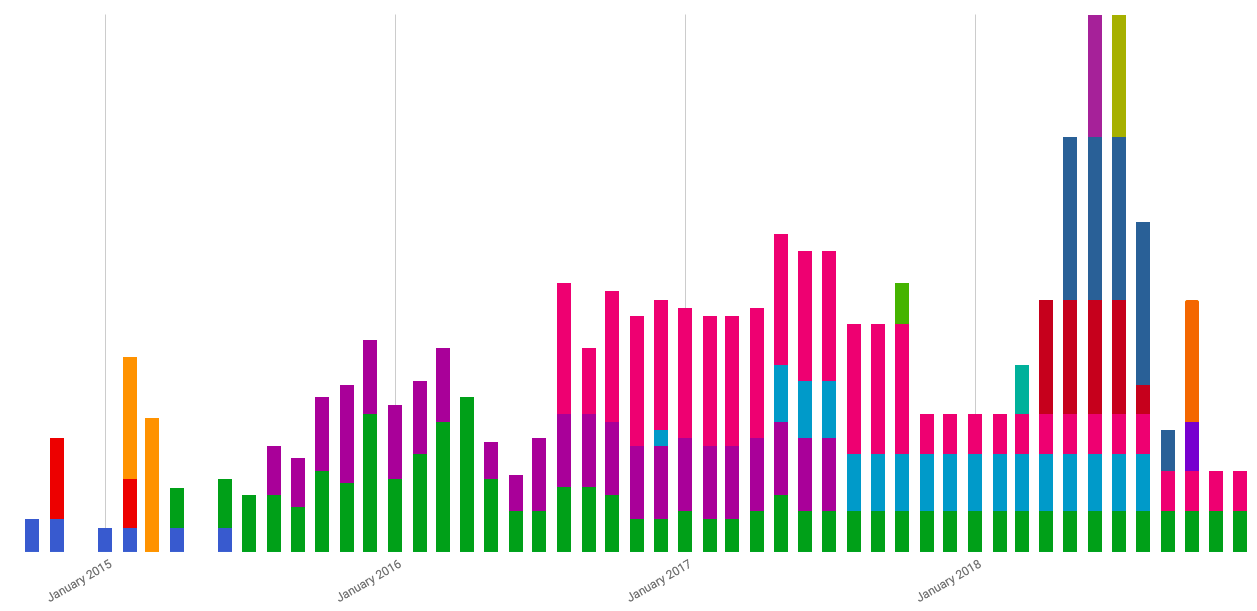 ↩
↩ -
For more on how focus on retained strategy work see my post strategy and stewardship ↩
-
More often these days Texas gets replaced by Tokyo which also tells you about globalization and the romantic brand of Tokyo vs Texas ↩
-
I started collecting examples and advice for making a capabilities deck over on my wiki page here ↩
-
Did you know Vladamir Nabakov, author of Lolita, was an avid butterfly collector and created some beautiful sketches? ↩

